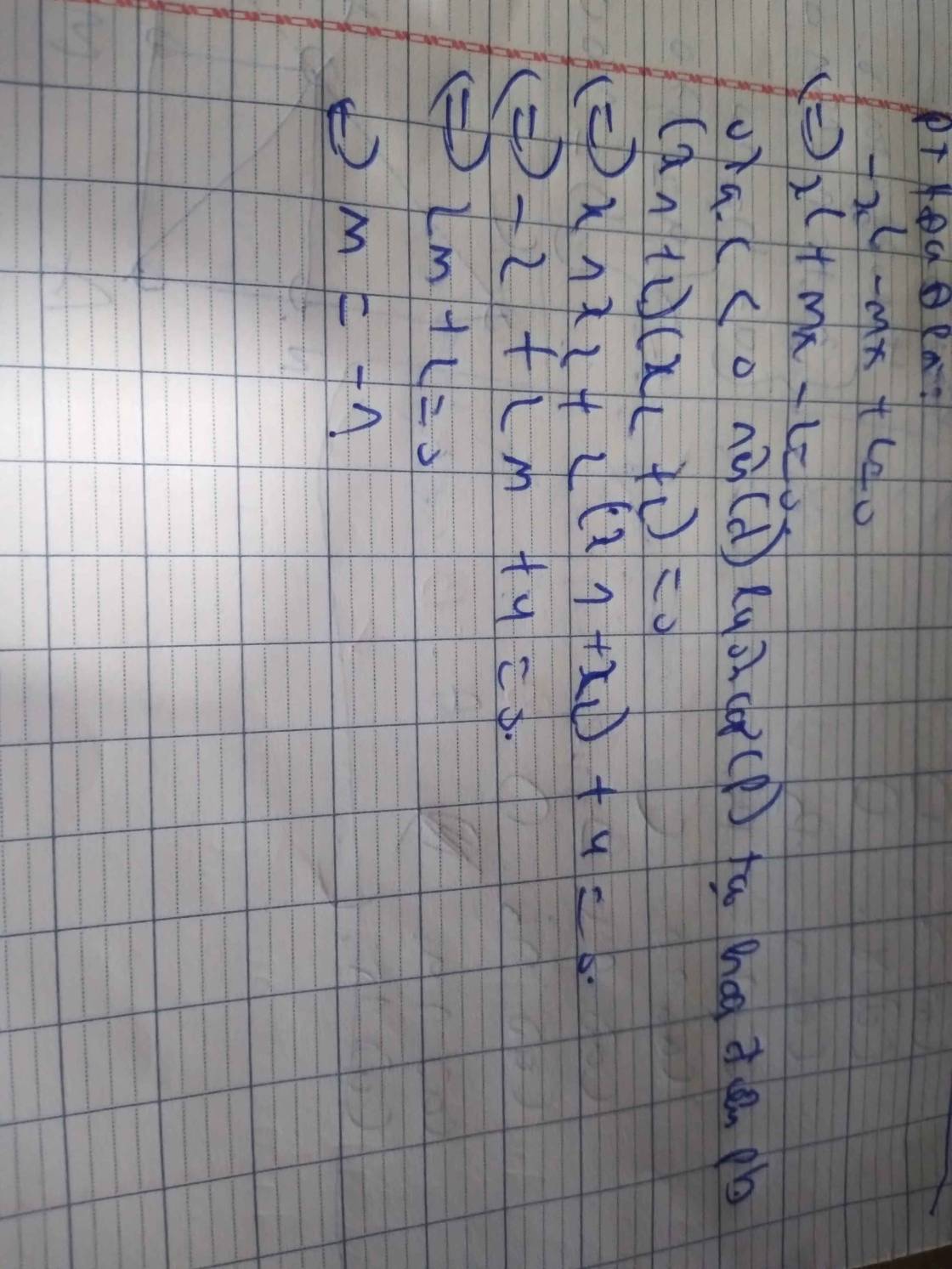Hãy nhập câu hỏi của bạn vào đây, nếu là tài khoản VIP, bạn sẽ được ưu tiên trả lời.

a) Khi m = 2 thì: \(\hept{\begin{cases}y=x^2\\y=2x+3\end{cases}}\)
Hoành độ giao điểm (P) và (d) là nghiệm của PT: \(x^2=2x+3\Leftrightarrow x^2-2x-3=0\Leftrightarrow\left(x+1\right)\left(x-3\right)=0\)
\(\Leftrightarrow\orbr{\begin{cases}x+1=0\\x-3=0\end{cases}}\Leftrightarrow\orbr{\begin{cases}x=-1\Rightarrow y=1\\x=3\Rightarrow y=9\end{cases}}\)
Vậy tọa độ giao điểm của (P) và (d) là \(\left(-1;1\right)\) và \(\left(3;9\right)\)
b) Hoành độ giao điểm của (P) và (d) là nghiệm của PT:
\(x^2=mx+3\Leftrightarrow x^2-mx-3=0\)
Vì \(ac=1\cdot\left(-3\right)< 0\) => PT luôn có 2 nghiệm phân biệt
Theo hệ thức viet ta có: \(\hept{\begin{cases}x_1+x_2=m\\x_1x_2=-3\end{cases}}\)
Mà \(\frac{1}{x_1}+\frac{1}{x_2}=\frac{3}{2}\Leftrightarrow\frac{x_1+x_2}{x_1x_2}=\frac{3}{2}\Leftrightarrow\frac{-m}{3}=\frac{3}{2}\Rightarrow m=-\frac{9}{2}\)
Vậy \(m=-\frac{9}{2}\)

1) ĐK \(\hept{\begin{cases}x\ne y\\y\ge-1\end{cases}}\)
Đặt \(\hept{\begin{cases}\frac{1}{x-y}=a\left(a\ne0\right)\\\sqrt{y+1}=b\left(b\ge0\right)\end{cases}}\)hệ phương trình đã cho trở thành
\(\hept{\begin{cases}2a+b=4\\a-3b=-5\end{cases}}\Leftrightarrow\hept{\begin{cases}2a+b=4\\2a-6b=-10\end{cases}}\Leftrightarrow\hept{\begin{cases}7b=14\\2a+b=4\end{cases}}\Leftrightarrow\hept{\begin{cases}a=1\\b=2\end{cases}\left(tm\right)}\)
\(\Rightarrow\hept{\begin{cases}\frac{1}{x-y}=1\\\sqrt{y+1}=2\end{cases}}\Leftrightarrow\hept{\begin{cases}x-y=1\\y+1=4\end{cases}}\Leftrightarrow\hept{\begin{cases}x=4\\y=3\end{cases}}\left(tm\right)\)
Vậy ...

1) ĐK \(\hept{\begin{cases}x\ge0\\y\ne1\end{cases}}\)
Đặt \(\hept{\begin{cases}2\sqrt{x}=a\left(a\ge0\right)\\\frac{1}{y-1}=b\left(b\ne0\right)\end{cases}}\)hệ phương trình đã cho trở thành
\(\hept{\begin{cases}a+3b=5\\2a-b=3\end{cases}}\Leftrightarrow\hept{\begin{cases}2a+6b=10\\2a-b=3\end{cases}}\Leftrightarrow\hept{\begin{cases}7b=7\\2a-b=3\end{cases}}\Leftrightarrow\hept{\begin{cases}a=2\\b=1\end{cases}\left(tm\right)}\)
\(\Rightarrow\hept{\begin{cases}2\sqrt{x}=2\\\frac{1}{y-1}=1\end{cases}}\Rightarrow\hept{\begin{cases}x=1\\y=2\end{cases}}\left(tm\right)\)
Vậy ...
1,\(\left\{{}\begin{matrix}2\sqrt{x}+\dfrac{3}{y-1}=5\\4\sqrt{x}-\dfrac{1}{y-1}=3\end{matrix}\right.\) ĐKXĐ:x≥o,y≠1
⇔\(\left\{{}\begin{matrix}4\sqrt{x}+\dfrac{6}{y-1}=10\\4\sqrt{x}-\dfrac{1}{y-1}=3\end{matrix}\right.\Leftrightarrow\left\{{}\begin{matrix}\dfrac{7}{y-1}=7\\4\sqrt{x}-\dfrac{1}{y-1}=3\end{matrix}\right.\)\(\Leftrightarrow\left\{{}\begin{matrix}y-1=1\\4\sqrt{x}-\dfrac{1}{y-1}=3\end{matrix}\right.\Leftrightarrow\left\{{}\begin{matrix}y-1=1\\4\sqrt{x}-\dfrac{1}{1}=3\end{matrix}\right.\Leftrightarrow\left\{{}\begin{matrix}y=2\\4\sqrt{x}=4\end{matrix}\right.\Leftrightarrow\left\{{}\begin{matrix}y=2\\\sqrt{x}=1\end{matrix}\right.\Leftrightarrow\left\{{}\begin{matrix}y=2\\x=1\end{matrix}\right.\left(TM\right)\)
vậy hpt đã cho có nghiệm duy nhất (x,y)=(1,2)
2,a, xét pthđgđ của (d) và (p) khi m=3:
x\(^2\)=3x-1⇔\(x^2-3x+1=0\)
Δ=(-3)\(^2\)-4.1.1=5>0
⇒pt có 2 nghiệm pb
\(x_1=\dfrac{3+\sqrt{5}}{2}\) ,\(x_2=\dfrac{3-\sqrt{5}}{2}\)
thay x=x\(_1\)=\(\dfrac{3+\sqrt{5}}{2}\) vào hs y=x\(^2\) ta được:
y=(\(\dfrac{3+\sqrt{5}}{2}\))\(^2\)=\(\dfrac{14+6\sqrt{5}}{4}\)⇒A(\(\dfrac{3+\sqrt{5}}{2},\dfrac{14+6\sqrt{5}}{4}\))
thay x=x\(_2\)=\(\dfrac{3-\sqrt{5}}{2}\) vào hs y=x\(^2\) ta được:
y=\(\left(\dfrac{3-\sqrt{5}}{2}\right)^2=\dfrac{14-6\sqrt{5}}{4}\)⇒B(\(\dfrac{3-\sqrt{5}}{2},\dfrac{14-6\sqrt{5}}{4}\))
vậy tọa độ gđ của (d) và (p) là A(\(\dfrac{3+\sqrt{5}}{2},\dfrac{14+6\sqrt{5}}{4}\)) và B (\(\dfrac{3-\sqrt{5}}{2},\dfrac{14-6\sqrt{5}}{4}\))
b,xét pthđgđ của (d) và (p) :
\(x^2=mx-1\)⇔\(x^2-mx+1=0\) (*)
Δ=(-m)\(^2\)-4.1.1=m\(^2\)-4
⇒pt có hai nghiệm pb⇔Δ>0
⇔m\(^2\)-4>0⇔m>16
với m>16 thì pt (*) luôn có hai nghiệm pb \(x_1,x_2\)
theo hệ thức Vi-ét ta có:
(I) \(\left\{{}\begin{matrix}x_1+x_2=m\\x_1.x_2=1\end{matrix}\right.\)
\(x_1,x_2\) TM \(x_2\)(x\(_1\)\(^2\)+1)=3
⇒\(x_2.x_1^2\)+\(x_2\)=3⇔\(x_2.x_1.x_1+x_2=3\)⇔(\(x_2.x_1\))(\(x_1+x_2\))=3 (**)
thay (I) vào (**) ta được:
1.m=3⇔m=3 (TM m≠0)
vậy m=3 thì (d) cắt (p) tại hai điểm pb có hoanh độ \(x_1.x_2\) TM \(x_2\)(\(x_1^2+1\))=3

a: Phương trình hoành độ giao điểm là:
x^2-mx-4=0
a*c<0
=>(d) luôn cắt (P) tại hai điểm phân biệt
c: x1^2+mx2=6m-5
=>x1^2+x2(x1+x2)=6m-5
=>(x1+x2)^2-x1x2=6m-5
=>m^2-(-4)-6m+5=0
=>m^2-6m+9=0
=>m=3

b: Thay m=2 vào (d), ta được:
y=2x-2+1=2x-1
Phương trình hoành độ giao điểm là:
\(x^2=2x-1\)
=>\(x^2-2x+1=0\)
=>(x-1)^2=0
=>x-1=0
=>x=1
Thay x=1 vào (P), ta được:
\(y=1^2=1\)
Vậy: Khi m=2 thì (P) cắt (d) tại A(1;1)
b: Phương trình hoành độ giao điểm là:
\(x^2=2x-m+1\)
=>\(x^2-2x+m-1=0\)
\(\text{Δ}=\left(-2\right)^2-4\cdot1\cdot\left(m-1\right)\)
=4-4m+4
=-4m+8
Để (P) cắt (d) tại hai điểm phân biệt thì Δ>0
=>-4m+8>0
=>-4m>-8
=>m<2
Theo Vi-et, ta có:
\(\left\{{}\begin{matrix}x_1+x_2=-\dfrac{b}{a}=2\\x_1x_2=\dfrac{c}{a}=m-1\end{matrix}\right.\)
y1,y2 thỏa mãn gì vậy bạn?

`a)` H/s nghịch biến trên `RR`. Vì `a=-2 < 0`
`b)` Ptr hoành độ của `(d)` và `(P)` là:
`-2x+m=x^2`
`<=>x^2+2x-m=0` `(1)`
`(d)` cắt `(P)` tại `2` điểm có hoành độ phân biệt `<=>` Ptr `(1)` có `2` nghiệm phân biệt
`=>\Delta' > 0`
`<=>1+m > 0<=>m > -1`
`=>` Áp dụng Viét có: `{(x_1+x_2=-b/a=-2),(x_1.x_2=c/a=-m):}`
Ta có: `|x_1-x_2|=4`
`<=>\sqrt{(x_1-x_2)^2}=4`
`<=>\sqrt{(x_1+x_2)^2-4x_1.x_2}=4`
`<=>(-2)^2-4.(-m)=16`
`<=>m=3` (t/m)

Phương trình hoành độ giao điểm:
\(-\dfrac{1}{2}x^2=mx+m-3\Leftrightarrow x^2+2mx+2m-6=0\) (1)
a. Khi \(m=-1\), (1) trở thành:
\(x^2-2x-8=0\Rightarrow\left[{}\begin{matrix}x=4\Rightarrow y=-8\\x=-2\Rightarrow y=-2\end{matrix}\right.\)
Vậy (d) cắt (P) tại 2 điểm có tọa độ là \(\left(4;-8\right)\) ; \(\left(-2;-2\right)\)
b.
\(\Delta'=m^2-2m+6=\left(m+1\right)^2+5>0;\forall m\Rightarrow\left(1\right)\) có 2 nghiệm pb với mọi m
Hay (d) cắt (P) tại 2 điểm pb với mọi m
Theo hệ thức Viet: \(\left\{{}\begin{matrix}x_1+x_2=-2m\\x_1x_2=2m-6\end{matrix}\right.\)
\(x_1^2+x_2^2=14\Leftrightarrow\left(x_1+x_2\right)^2-2x_1x_2=14\)
\(\Leftrightarrow4m^2-2\left(2m-6\right)=14\)
\(\Leftrightarrow4m^2-4m-2=0\Rightarrow m=\dfrac{1\pm\sqrt{3}}{2}\)

a) Xét phương trình hoành độ giao điểm chung của (d) và (P) :
\(x^2=\left(2m-1\right)x-m^2+2\)
\(\Leftrightarrow x^2-\left(2m-1\right)x+m^2-2=0\left(1\right)\)
Thay m=2 vào pt (1) ta được:
\(x^2-3x+2=0\)
\(\Leftrightarrow\orbr{\begin{cases}x=1\Rightarrow y=1\\x=2\Rightarrow y=4\end{cases}}\)
Tọa độ giao điểm của (d) và (P) khi m=2 là \(A\left(1;1\right);B\left(2;4\right)\)
b) \(\Delta_{\left(1\right)}=\left(2m-1\right)^2-4m^2+8\)
\(=4m^2-4m+1-4m^2+8\)
\(=9-4m\)
Để pt (1) có 2 n ghiệm pb \(\Leftrightarrow9-4m>0\Leftrightarrow m< \frac{9}{4}\)
Theo hệ thức Vi-et ta có:
\(\hept{\begin{cases}x_1+x_2=2m-1\\x_1.x_2=m^2-2\left(1\right)\end{cases}}\)
Ta có: \(\hept{\begin{cases}x_1+x_2=2m-1\\x_1-3x_2=7\end{cases}}\)
\(\Leftrightarrow\hept{\begin{cases}3x_1+3x_2=6m-3\\x_1-3x_2=7\end{cases}}\)
\(\Leftrightarrow\hept{\begin{cases}x_1=\frac{3m+2}{2}\\x_2=\frac{m-4}{2}\end{cases}\left(3\right)}\)
Thay (3) vào (2) ta được:
\(\frac{3m+2}{2}.\frac{m-4}{2}=m^2-2\)
\(\Leftrightarrow\frac{3m^2-10m-8}{4}=m^2-2\)
\(\Rightarrow3m^2-10m-8=4m^2-8\)
\(\Leftrightarrow m^2+10m=0\)
\(\Leftrightarrow\orbr{\begin{cases}m=0\\m=-10\end{cases}\left(tm\right)}\)
Vậy ...